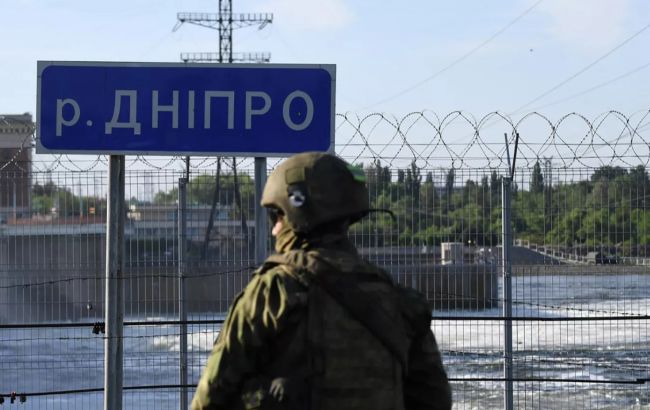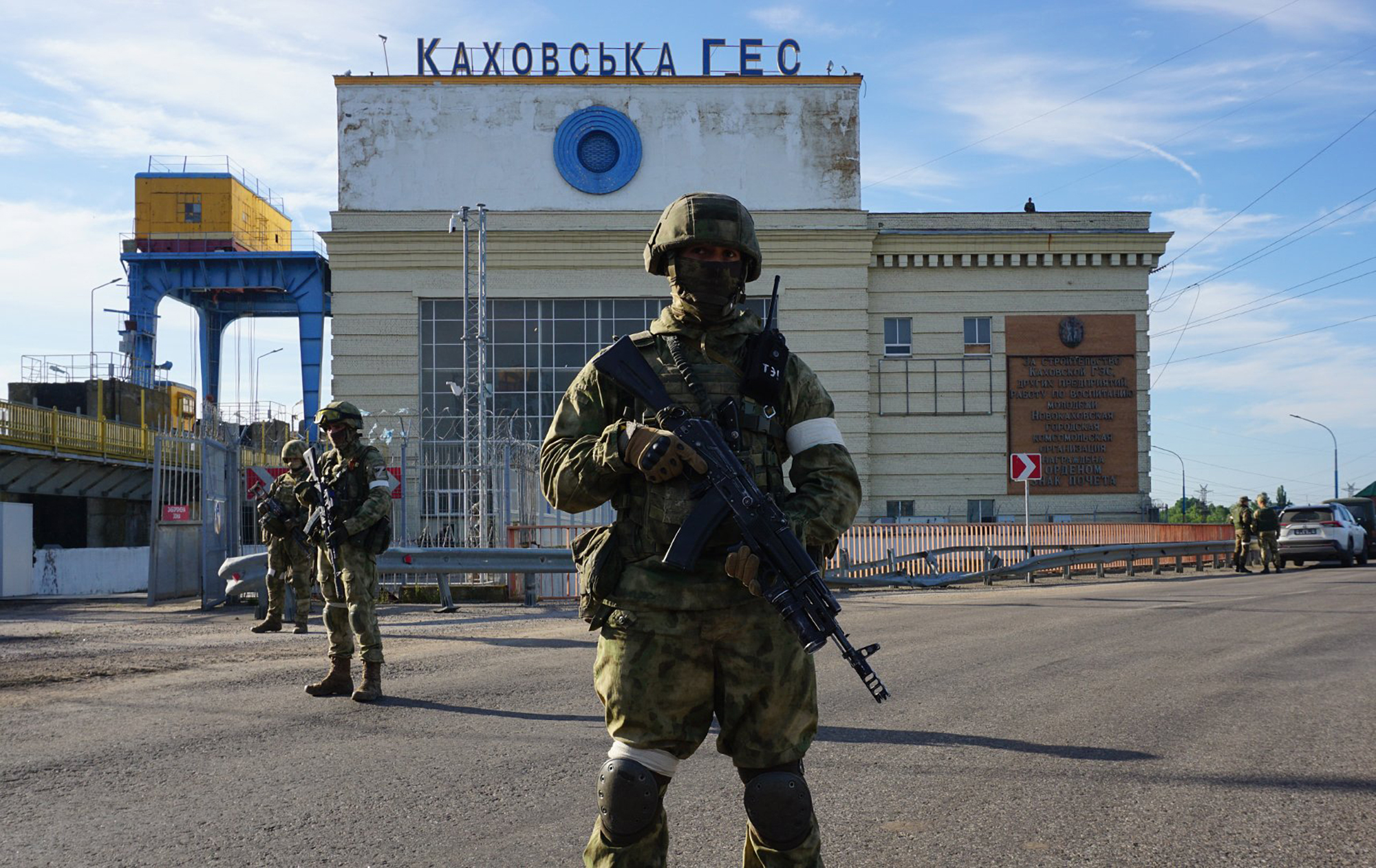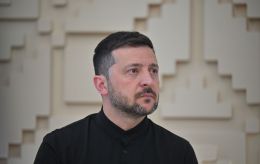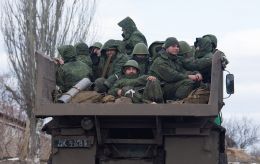Another blunder. Why Russia blows up Kakhovka HPP and 'washes away' its defense?
 June 6, Russian soldiers destroyed Kakhovka HPP dam (Photo: Russian media)
June 6, Russian soldiers destroyed Kakhovka HPP dam (Photo: Russian media)
Russian forces, in an attempt to thwart Ukraine's offensive, sabotaged the Kakhovka hydroelectric power plant in the Kherson region. However, it appears their plan backfired and ended up flooding their defensive lines.
So, why Russia would take this extreme military action, and how will it impact the battlefield?
The West hesitates to point fingers at Russia
Ukrainian President Volodymyr Zelenskyy responded to the sabotage of the Kakhovka HPP by blaming Russian terrorists. According to him, the destruction of the dam once again demonstrated to the world that the invaders need to be driven out from every corner. He emphasized that only a military victory of Ukraine can restore safety.
Ukrainian intelligence reports that Russians had mined the HPP immediately after capturing it, and in April 2022, additional explosives were set on the gates and supports. Andrii Yusov, a representative of the Defense Intelligence of Ukraine, stated that the explosion on the night of June 6 was carried out remotely.
"Speaking of the evidence base, it exists, and its collection continues. There are numerous direct and indirect testimonies indicating that not just the Russian Federation, but its military-political leadership, is behind the destruction of the dam," he adds.
Oleksiy Danilov, Secretary of the National Security and Defense Council of Ukraine, is convinced that the dam was blown up on the order of Russian President Vladimir Putin. He believes such an act of terrorism could only come from the Kremlin office.

Oleksiy Danilov, Secretary of the National Security and Defense Council of Ukraine (Photo: Vitalii Nosach/RBC-Ukraine)
The Ukrainian side has also named the perpetrators. Preliminarily, the attack is believed to have been carried out by representatives of the 205th Separate Motorized Rifle Brigade of the Russian Armed Forces. In October, it was mentioned on the unit's Telegram channel that the dam would likely be blown up in case of "uncontrolled advancement" by the Ukrainian Defense Forces.
The HPP was sabotaged amid the Russian Defense Ministry's claims about an alleged Ukrainian offensive, which circulated since the beginning of the week. This is officially denied in Kyiv, with the military speaking only about local successes in the Bakhmut area of the Donbas region.
The catastrophe caused a significant resonance in the West. However, not all of Ukraine's allies have been quick to make strong statements. For example, British Foreign Secretary James Cleverly held Russia responsible but noted that it was still early to make a substantial evaluation of the details. Prime Minister Rishi Sunak announced that his intelligence services are looking into the details.
US President Joe Biden also refrained from judgments. He expressed support and promised to assist Ukraine in dealing with the consequences. White House spokesperson Karine Jean-Pierre, however, implied that Russia is responsible.
"… this dam was under Russia's control, and they bear responsibility for the destruction caused by this war," she said, adding that if Russia had not launched a full-scale invasion of Ukraine, this tragedy would not have occurred.
Oleksiy Danilov associates the restrained reaction of some partners with the fact that this crime falls under the Geneva Conventions and international law. Therefore, some countries want to thoroughly study the issue. The Secretary believes that the global community's reaction will continue for several more days, and eventually, "the civilized world will be on our side".
Western media showed their 'best side'
The coverage of the dam explosion in global media may have influenced the restrained position taken by the West. Many reputable publications approached the issue dubiously.
For example, Reuters and The New York Times did not explicitly attribute responsibility to Russia in their articles about the attack. Bild initially ran a headline stating, "Russians blew up a huge dam in Ukraine," but later the reference to Russia disappeared.
Most media avoided strong statements and instead wrote about mutual accusations between the Russian and Ukrainian sides.
This approach to news reporting angered Ukrainian Foreign Minister Dmytro Kuleba.
“Infuriating to see some media report "Kyiv and Moscow accusing each other” of ruining the Kakhovka dam. It puts facts and propaganda on equal footing. Ukraine is facing a huge humanitarian and environmental crisis. Ignoring this fact means playing Russia’s “not all obvious” game," he wrote on Twitter.
Deputy Minister of Defense Hanna Maliar saw the Russian trace in the publications of the Western press. In her opinion, all the publications mentioning the alleged Ukrainian Armed Forces' attack were paid for by the Kremlin.
"This is a typical tactic of the Russian Federation. Whenever they commit crimes, they try to involve us as accomplices. This is not the first time," she noted.
Maliar also emphasized that Russia has become so toxic today that its statements hold no significance worldwide. Therefore, the Kremlin promotes its narratives for money and is ready to invest in countries willing to defend the desired position.
‘Schizophrenia’ at the Security Council and UN inaction
Following the sabotage of the Kahovka HPP, an emergency meeting of the UN Security Council was convened. According to Minister Dmytro Kuleba, Russia tried to obstruct the meeting, but it failed.
Permanent Representative of Russia Federation to the United Nations Vasily Nebenzya predictably accused Ukraine of sabotaging the power station.
"The Kyiv regime committed an unthinkable crime – the destruction of the Kahovka dam, resulting in an uncontrolled water discharge downstream of the Dnipro River... The conclusion (that Russia blew up the HPP – Ed.) reeks of schizophrenia, perhaps not even a latent one," the Russian diplomat claimed.

Vasily Nebenzya, Permanent Representative of Russia Federation to the United Nations (Photo: Getty Images)
In response, Ukrainian Ambassador Sergiy Kyslytsya accused Moscow of employing scorched-earth tactics, or in this case, flooding tactics. He stated that there was little chance that a country that denies its war crimes in Mariupol and Bucha would take responsibility for a human-made catastrophe.
Furthermore, the dam sabotage is another example of genocide against Ukrainians and a response to countries advocating for peace negotiations, according to Kyslytsya.
Martin Griffiths, UN Under-Secretary-General for Humanitarian Affairs and Emergency Relief Coordinator, acknowledged the serious and far-reaching consequences for hundreds of thousands of Ukrainians but clarified that the full extent of the impact would only be known in a few days. On the same day, Ukrainian President Volodymyr Zelenskyy criticized the UN and the Red Cross for their inaction. In his view, these organizations should have been the first on-site and save people, but Ukraine received no response to its pleas for help.
Today, an agreement regarding the evacuation of people from the occupied left-bank part of the Kherson region with the UN was reached. The relevant groups will be formed in Kherson and Zaporizhzhia, but their work will begin only after guarantees of safety from Russians are provided.
Why did Russians blow up the Kahovka dam?
The most obvious reason is that the enemy does not know where the Ukrainian counteroffensive will start and is trying to thwart it. Deputy Minister of Defense Hanna Maliar claimed Russians wanted to hinder the evacuation and shift attention away from the events in the Belgorod region, but they achieved the opposite effect.
Zelenskyy believes that the dam was intentionally destroyed to blackmail the world and to use water as a weapon.
Institute for the Study of War analysts see the pragmatic interests of the occupiers in flooding the downstream of the Dnipro River. In particular, its expansion is intended to hinder the Ukrainian Defense Forces from the river crossing. Some published footage suggests that certain Ukrainian positions near the river were flooded, and soldiers were forced to retreat.
Military and political expert from the “Informatsiinyi sprotyv” ("Information Resistance") group, Oleksandr Kovalenko, agrees that the enemy in the Kherson region fears a possible Dnipro crossing by the Ukrainian forces. However, there may be other objectives.
"They provoked such a massive catastrophe to divert our resources to addressing humanitarian problems. In this way, they want to slow down the preparation for the counteroffensive," he noted.

Russians may have pursued several goals (Photo: Russian media)
However, seeking logic in the Russians' actions may be pointless. Military expert Vladyslav Seleznov believes that the Ukrainian Armed Forces do not have the technical capabilities for a successful crossing. He also reminds that the only large landing ship “Kostiantyn Olshanskyi” has been in occupied Sevastopol since 2014.
He thinks that other elements of the Ukrainian Navy are unable to facilitate the movement of sufficient military equipment and personnel from the right to the left bank of the Dnipro.
"But it seems to me that Russians are trying to avoid even illusory risks associated with the Ukrainian counteroffensive. That's why they resorted to such an audacious provocation. They also flooded their trenches and other defensive structures that they built for several months. Now it will take time to rebuild them," he added.
Expert Oleksii Hetman mentions another possible goal. Russians understand that they cannot hold the South and are already looking for ways to retreat. They cannot talk about withdrawal, and the "gesture of goodwill" story is unlikely to be sold for the third time. There is one option left – they can claim that Ukraine destroyed the dam and flooded the defensive structures on the left bank. After that, they will retreat at least 10-15 kilometers.
"We will find out later what the main goal was. And perhaps we won't. Ultimately, what difference does it make? This is an act of terrorism. The dam destruction is considered by UN normative documents equivalent to the use of weapons of mass destruction," he added.
Russian positions
The experts do not rule out that Russians had been planning to blow up the Kahovka HPP for a long time, but something went wrong. The jamming of communications in the plant area and cancellation of investigations at hazardous facilities just a few days before the disaster favor the version of a planned act of terrorism.
According to Natalia Humeniuk, Head of the United Coordinating Press Center of Security and Defense Forces of the South of Ukraine, they have already had to retreat 5-15 kilometers in some areas. According to the Ukrainian General Staff's data, some units have suffered casualties in personnel and equipment.
ISW analysts note that Oleshky, Hola Prystan, and Dnipriany settlements on the left bank of the Dnipro River have been almost completely flooded. The Russian army's defenses are reportedly significantly damaged by the sudden flooding, causing the loss of their front-line defenses. Russian forces have likely withdrawn from at least Oleshky and Hola Prystan. Additionally, the flooding has reportedly washed away Russian minefields.
According to CNN, there are witnesses of the Russians' positions flooding. Ukrainian officer Andrii Pidlisnyi states that many Russian soldiers died in panic, with no chance to evacuate. All battalions on the affected bank are now underwater, according to him.
"Russians had planned the dam sabotage for some time, preparing to execute it during their retreat. Perhaps they were preparing something less grand, but things didn't go as planned. Now, until the water recedes, the enemy will retreat, and only those capable of providing defense against a possible airborne assault will remain," says analyst Oleksandr Kovalenko.
It is impossible to predict the structure of Russian defenses on the left bank. Analyst Oleksii Hetman suggests the flood may help their defense, but only if the Ukrainian army moves on to active actions.
"But it seems to me that Russians made a mistake in their assumptions about where we plan our offensive," he adds.
What’s next
Ukrainian command has been preparing for the possibility of Russia destroying the hydroelectric power plant. Earlier, Commander of the Joint Forces Serhii Naiev claimed that all calculations and contingencies have been made.
"Accordingly, it should not hinder our offensive in the areas that may be affected by the flood," he says.
Notably, the preparations weren't only military. Ukrainian President Volodymyr Zelenskyy stated that the risks were recognized last year, and rescue teams were formed in advance. Up to 80 populated areas are expected to be flooded, and drinking water problems are anticipated in the Kherson, Zaporizhzhia, and Dnipropetrovsk regions.
The President also emphasized that Russia's actions haven't impeded Ukraine's ability to liberate its territories.
Vladyslav Seleznov predicts a decrease in mortar attacks due to their limited effective range of 6 km. However, Russian artillery continues to shell Kherson and the suburbs. Apart from the first line, the rest of the frontlines remained unaffected by the water.
Meanwhile, he notes that Russians are preparing defensive structures closer to Crimea, possibly fearing a southward push from the Ukrainian Armed Forces from the Zaporizhzhia region. Despite minefields and a significant number of trenches, Seleznov believes this would not significantly impact the ability to advance.
One thing is clear – Ukraine wasn't caught off guard and knows how to proceed. While military experts find it hard to predict the exact next steps, it certainly won't involve a scenario where the Kahovka HPP remains intact.

